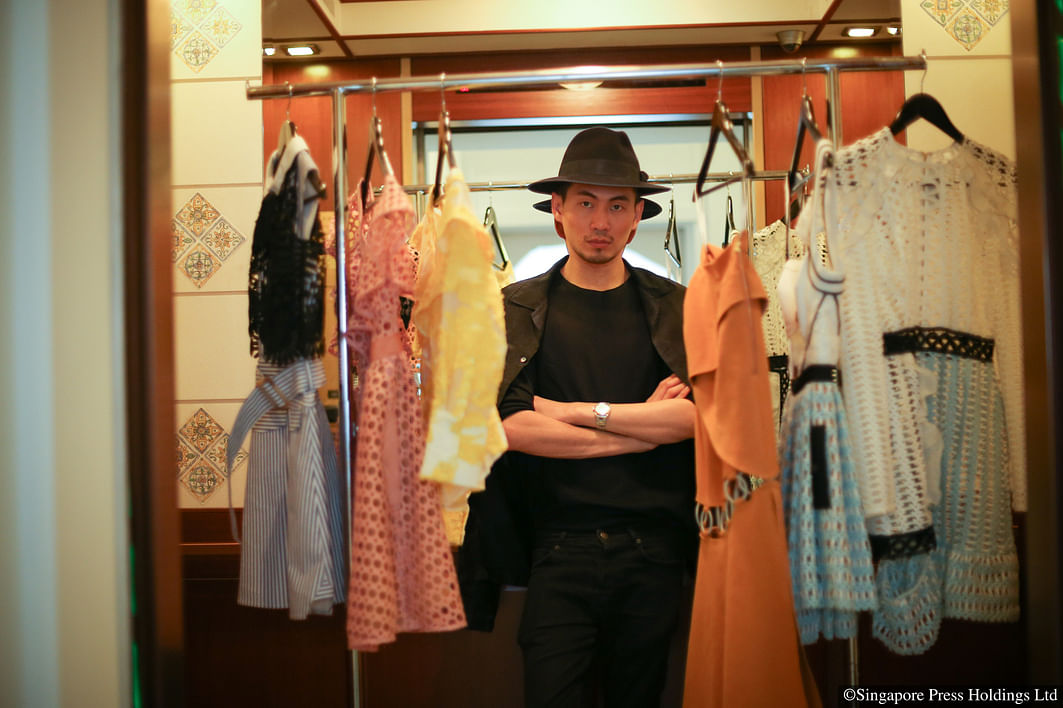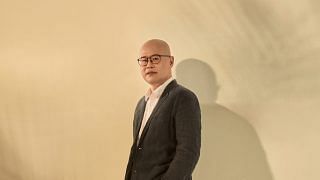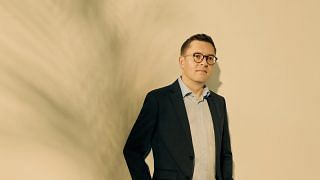[dropcap size=small]G[/dropcap]rowing up in Penang in the pre-Internet days of the early 1990s, Han Chong would wait eagerly for fashion magazines to arrive in his sleepy home town of Sungai Ara.
But by the time the magazines landed at the newsstands, some of the trends they reported on would already be on their way out.
These days, you’d find his face in those same magazines, and he’s the one setting fashion trends. Han, 38, is the creator of Self-Portrait, a label he started in London in 2013.
It found success very quickly. Self-Portrait was picked up – and sold out – by retailers such as Selfridges and Net-a-porter, celebrities started appearing in them, and it was praised by the fashion press.
The look is lace, but modernised and made quirky with strips of leather, suede and sheer panels. The quality of the lace is high, yet prices are, in Chong’s word, “achievable” – about $350 for a top and $650 for a dress.
Although he was born across the Causeway, it’s only his second-ever visit to Singapore, says Chong, who was here for the Singapore Fashion Week late last year when we meet for lunch. His first visit was 20 years ago.
The last few years have been “really crazy”, says Chong, who is now based in London. A scroll-through of his Instagram account @mrselfportrait – he has 403,000 followers – reveals a glamorous life of travel, fashion shows and celebrities in his clothes.
It’s all a long way from Penang. He was born in the capital Georgetown, the oldest of three children, but spent his childhood with his grandmother and many aunts in the countryside of Sungai Ara, near the airport.
Those were carefree days, he recalls. “There’s nothing there,” he says in charmingly choppy and accented English, “but it was fun because it’s all like nature… waterfall and all that. ”
Fashion was not a big thing in Sungai Ara or in his family, he tells me as the waitress appears with the food. His mother worked as a sales assistant in a department store and his father has a bak kwa – barbecue pork – business.
Growing up among so many females made him “understand women a bit more”, he says. One of his aunts was a painter who inspired the more artistic side in him and taught him to appreciate beauty. The biggest fashion events then were weddings. He would watch, fascinated, as the women around him dressed up.
He studied at Equator Academy of Art, a private institute that taught art and design, for two years, and later attended classes by Jing Ooi, a Malaysian tutor who had studied at London’s famous art and design school, Central Saint Martins. Ooi opened his eyes to design and a world beyond Penang.
When he was 19, Chong went to Kuala Lumpur to work for a designer who also organised events such as fashion shows. He picked up a bit of everything involved in the fashion world, from hair, make-up and styling to photography.
When he was 22, he said to himself that “oh, it’s not enough, I want more”. As he puts it: “KL is good but the market is quite small. People don’t buy too much fashion, they buy handbags.”
He decided to head for London and get a job there. But finding work was harder than he’d imagined. A friend suggested he try for a place at Central Saint Martins. “I went and they said, ‘Oh, you’re really good, I want you to enrol’ and I was like, ‘Really?’ because, at that time, it was quite hard to get into Saint Martins.”
He begged his father to pay his fees and although it was tough for the family, they managed it.
After he graduated in 2005, he worked for high street retailers in London. In 2011, he and a few others launched the label Three Floor, which also sells lacy clothes with an attitude. He was its creative director but left after two years because there were “too many cooks”.
He decided to set up his own label, Self-Portrait, with help from investors. “I thought, since I did it once, I can do it again by myself, so I will be in more control.”
The label’s name, he has said in past interviews, plays on the idea of how people express themselves through clothes.
The brand started with just him and an intern. “But I was so hungry for it, I really wanted to make it. I was like working so hard but I really love doing it because it’s like, oh, it belongs to you.” The early days were tough. The factory he was working with baulked at his designs. “They said, ‘You crazy, you got like 60 pieces of small trim and fabric join into one dress, I’m not doing this for you’.”
His first collection in 2013 was three months behind schedule. Luckily, everything fell into place. What he had going for him were loyal store buyers who knew his work from his Three Floor days and who had faith in his new brand.
Selfridges was the first major stockist to sell his designs, in 2014. Online retailer Net-a-porter was also an early adopter. His clothes there sold out within a day. Jennifer Lopez was the first celebrity to be photographed in a Self-Portrait creation. She wore a US$275 black-and-white tuxedo wrap dress as a judge on American Idol in March 2014.
His dresses also started popping up on Instagram and got even more buzz when worn by influential fashion bloggers. He began to get a lot of good press.
Success has opened doors. “A lot of people are willing to work with me now, you know, like a really good photographer or a really good stylist, models,” he says without any trace of boasting. “At the beginning when we were small, all this was like a distant dream.”
He has kept prices relatively affordable. He remembers his student days in London when friends would want to dress well but didn’t want High Street looks, yet could not afford designer wear.
He has priced his clothes so that “if you are student, you save up a little bit, you can still buy it. It’s achievable. That’s very important to me”.
He’s exploring opening a standalone store in London but won’t rush into it. “You know, I’m not too crazy, like, I’m quite sensible.” Similarly, he isn’t thinking about going into menswear because “I still got a lot of things I want to do with women”.
I ask about his creative process and he says he puts himself in the shoes of his customers and imagines what they’d be wearing in the months ahead, what movies they’d be watching and what parties they will be going to. He also soaks in what’s happening on social media, at the art galleries he likes to visit, and when he travels.
With all these images in his head, he holes himself up at home for a few weeks and puts together a new collection.
He has a habit of drawing “really tiny” images, he says, spreading his right thumb and forefinger an inch wide to illustrate. A collection of 50 of such sketches fills two pages of his notebook. At a glance, he can mix and match the pieces.
He does a lot of fittings on his female friends “because they can be, like, really honest”.
His seamstresses are in Guangzhou in China, which he visits every other month. He has reached a stage where he develops lace in-house. He shares with me a video on his phone which shows a lace fabric being made, and marvels: “It takes 28 hours to embroider this front panel. And then, back panel 28 hours.”
I remark that success seems to have come rather easily to him. He ponders this, then says he has worked really hard but “because I want it so much, then it seems like everything is not that difficult, you know, you enjoy the journey”.
He acknowledges the role social media has played in publicising his label. He likes social media because the users are young and honest, and “it’s very personal and it’s really fast – information comes really quickly”.
Chong, who is not married, lives in the creative Shoreditch district of London and his office is within walking distance. He has a small team of about 14 people.
Does he have any advice for a budding designer from Penang – or Singapore, for that matter – who dreams of the sort of success he is enjoying?
He narrows his eyes to think, then says “be hungry, be curious” about the world around you. This is much easier now because the world has become so much smaller with the Internet, he says, unlike when he was growing up in Penang waiting for those fashion magazines.
Another thing: Don’t feel you have to get out of Asia to become big. “People always thought, ‘Oh, I need to go to Paris and stuff’, but Asia is so huge,” he says. “The business just for Asia is bigger than Europe… If you just do it really well in Asia, that’s more than enough.”
It’s not easy to stay ahead of the game in the competitive world of fashion. Too much exposure is not necessarily a good thing; cheap, badly-made copies of his designs that have come onto the market are a bane; and there’s always the fear of being a one-hit wonder.
His recent collections have experimented beyond the lacy dresses he is famous for. At his first runway show at New York Fashion Week last month, he showcased more tailored pieces and fabric like wool, suede and velvet. The reviews were good, but not fantastic.
But he is open-minded. “I never have an ego for my own creativity,” he says before he leaves for another appointment. “We are not perfect, you know. It’s like, we learn. And we do sh** things, we do good things. But if you have, like, the process, you go through, you learn, and then next time, you do better.”
Adapted from The Sunday Times.









